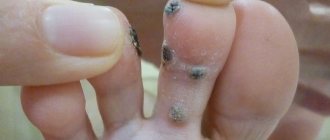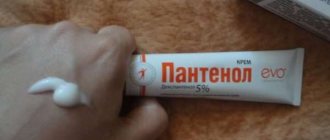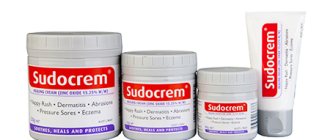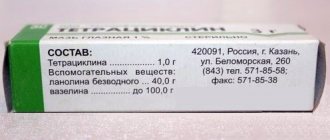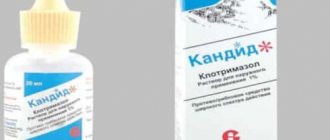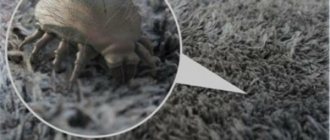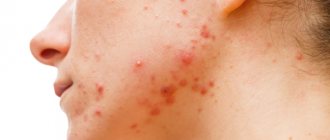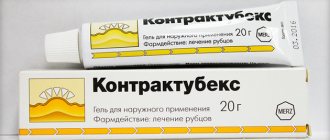Local antiseptics, including Tsindol, are almost always prescribed for acne . Their main goal is to eliminate bacteria that are actively involved in the pathogenesis of acne. Antiseptic agents are quite effective in complex therapy; they can be combined with each other and with some other medications for both local and systemic use.
Composition and release form
The only form of release of the drug Tsindol is a solution intended for external use. Sometimes there is information about Tsindol ointment, which is a common mistake that arose due to confusion with zinc ointments.
However, such a remedy is sometimes prepared at home; to do this, it is enough to let the bottle with the solution sit until a thick sediment forms at the bottom of the container. Its consistency allows for local use as an ointment that retains the basic properties of the drug, which is why the solution is also called mash.
The main active ingredient of Tsindol is zinc oxide; its content in 100 ml of solution is 12.5 g.
The composition also contains the following components:
- 70% ethyl alcohol - has a drying effect;
- Distilled water is a substance that nourishes the skin;
- Medical talc - has excellent adsorbing properties, removes excess moisture;
- Starch - saturates the skin with useful substances and vitamins, improves its tone;
- Glycerin - helps regulate skin moisture.
Zinc oxide has healing and antiseptic properties, due to the denaturation of protein in the substance, and is also the best UVA reflector and a key ingredient in sunscreen lotions, creams for
diapers, baby powders and acne creams.
Tsindol is sold in pharmacies, the main type of packaging is opaque glass bottles of 100 or 125 ml.
Video about the treatment of chickenpox
In Dr. Komarovsky’s studio, visitors, together with a famous pediatrician, examine in detail the consequences of the disease and the correct methods of treatment.
Although chickenpox is considered a mild disease, the accompanying symptoms cause severe discomfort to the child. And if there are any safe remedies that relieve itching and prevent the appearance of scars, then parents are simply obliged to use them. Share your stories of how your children suffered from chickenpox, what brought relief during the illness, and what you would never recommend. Your experience will help others reach recovery more easily and quickly.
Indications for use
The use of Tsindol solution is necessary if the patient has the following indications:
- Local inflammatory lesions of the skin arising from systematic exposure to moisture or mechanical friction;
- Skin irritations caused by increased sweating;
- Necrosis of soft tissues caused by systematic pressure;
- Dermatitis such as contact, diaper and allergic;
- Various forms of ulcerative skin lesions and violation of the integrity of the upper layers of the epidermis;
- Thermal burns of the first and second degree;
- Dermatological diseases caused by streptococcus;
- Herpes and chickenpox;
- Eczema at the acute stage, the only exception is the purulent form of the disease;
- Excessive acne and subcutaneous pimples.
Reviews
“After trying chatterbox T, I realized that it was not suitable for me. It dries the skin too much, and with my illness this is unacceptable. “I had to abandon it in favor of another drug that does not cause such dryness, and at the same time has a similar antibacterial and anti-inflammatory effect.”
“My daughter had stage 4 acne, no matter what we tried, nothing helped, but the doctor recommended a chatterbox, and after a few days the acne disappeared.”
Useful properties and effect of the drug
The use of Tsindol solution allows you to achieve the following positive results:
- Drying wounds and wet lesions on the skin , leading to accelerated regeneration of damaged tissues;
- Antiseptic treatment , due to which pathogenic microflora is removed and protection is provided against the addition of secondary infections;
- Suppression of acute inflammatory processes occurring in areas of skin lesions;
- Compaction of the upper layers of the epidermis , leading to a decrease in their permeability.
Such dermatotropic properties of Tsindol are due to the presence of zinc oxide in the solution, which makes it possible to effectively combat pathological processes occurring in different layers of the epidermis.
All positive results are achieved due to the following effects of the drug:
- Ensuring the synthesis of albumin salts and changing other protein compounds at the molecular level;
- Reduced activity of enzymes responsible for the development of inflammatory processes;
- Reducing the volume of fluid secreted in areas of inflammation;
- Creation of a protective antibacterial layer consisting of denatured proteins;
- Softening irritated skin areas.
Mechanism of action on acne
The medicine Tsindol has the ability to penetrate deeply into the epidermis. Due to this, all components of the drug are immediately put into action, providing an antiseptic effect. In the affected areas, harmful microorganisms are destroyed, which precisely cause the inflammatory process.
The product dries out existing wounds and accelerates their healing. Pimples and blackheads begin to gradually disappear from the skin surface. At this moment, cellular regeneration is activated, which prevents the occurrence of new rashes.
The composition of the drug perfectly softens scars, ensuring perfect and clean skin condition. Due to its astringent properties, the epidermis is additionally protected from the harmful effects of external factors. In contact with the skin surface, the components of the drug Tsindol create a protective film on it. This produces analgesic and antimicrobial effects.
By interacting with the sweat glands, the drug helps reduce their activity, thereby eliminating the increased fat content of the epidermis. And due to the fact that the walls of the capillaries become more elastic, the formation of vascular networks is prevented.
How to use it correctly?
Basic rules for the use of Tsindol, which must be followed for any indications and purposes:
- The solution can only be used for external use;
- It is necessary to avoid its contact with mucous membranes and the gastrointestinal tract;
- To increase safety, it is recommended to use personal protective equipment, including disposable medical gloves.
Preparation for use of Tsindol
Preparation for use of the solution is carried out in accordance with the following instructions:
- Only dry and clean skin is allowed to be treated , so the affected areas are washed with warm water before the procedure - this must be done carefully so as not to cause even more damage;
- The washed area of skin is blotted with cotton napkins or a towel , but friction and other methods of mechanical impact must be avoided;
- The affected area of skin must be kept in the open air for 10-15 minutes to completely dry the surface of the skin;
- Tsindol solution has a tendency to precipitate , so the bottle with the drug should be shaken before use to ensure a uniform and uniform structure.
General rules for use for skin lesions
The standard regimen for using Tsindol is used in the treatment of most dermatological diseases, during which pharmacological preparations based on zinc are prescribed.
Consists of the following features:
- The volume of solution used is determined individually depending on the area of the lesion : there is no need to use too much of the drug, it is enough to cover the affected areas of the skin with a thin, uniform layer;
- If the affected area is small, it is most convenient to apply Tsindol in a targeted manner using a cotton swab. For extensive lesions, sterile swabs or cotton pads are used for these purposes;
- The drug should remain on the skin for 2-4 hours , during this period it is necessary to avoid contact with the treated surface;
- After the specified period has expired, Tsindol is washed off the skin with warm water ; soap and other hygiene products do not need to be used;
- The procedure is repeated 4 to 6 times a day depending on the severity of the lesions;
- The duration of the course is determined individually and depends on the positive dynamics ; treatment is carried out for at least 3-4 days.
If it is necessary to take a course lasting more than a month, it is necessary to coordinate the treatment with a specialist.
Use for severe lesions
For severe and extensive skin lesions, masks based on Tsindol are used.
Application is carried out according to the following scheme:
- The product is applied in layers , using both the solution itself and the sediment, which has a thick structure and is more suitable for such an application;
- Wait 10 minutes and repeat applying the product to the dried layer;
- Apply gauze to the treated areas and moisten the top with cool water;
- After 20 minutes, remove the gauze , but do not rinse off the remaining product;
- If you have oily skin, you don’t have to wash off the drug ; in other cases, remove its remnants 4-5 hours after the procedure;
- At the final stage, it is recommended to carry out additional treatment using an alcohol solution based on salicylic acid and cosmetic products for skin care with a moisturizing and nourishing effect;
- Between applying masks with Tsindol, it is necessary to maintain a break of 4 days ; for dry skin, you can take a break of 5-6 days;
- It is necessary to continue this use of the solution until the damaged area of skin is completely healed . In any case, the duration of the course should not exceed 2 months.
Use for wounds and burns
When treating thermal burns and wounds on the skin surface, the solution is used according to one of the following schemes:
- Treat with a solution and apply a thin layer to the affected area of skin . A gauze bandage is applied on top only if protection from external factors is necessary;
- Wetting a sterile dressing that is applied to deep wounds or extensive burns . The bandage should be worn on an ongoing basis; it is changed after standard hygiene procedures, the solution has dried, or in accordance with the chosen method of treatment.
Use for diaper dermatitis
One of the indications for the use of Tsindol is diaper dermatitis.
His treatment is carried out in accordance with the following instructions:
- Treatment begins immediately after the first signs of diaper dermatitis appear , even with mild irritation;
- The solution is applied locally only to areas of the skin that are affected or have contact with wet underwear;
- Scheduled treatment is carried out 3 times a day , additionally the procedure is carried out when changing wet underwear.
Use for chickenpox and herpes
When treating chickenpox or herpes, Tsindol is used according to the following scheme:
- A cotton swab is moistened in the solution, after which spot treatment of skin rashes is carried out;
- The procedure is repeated 1-2 times a day at equal intervals;
- Tsindol is used only as an adjuvant, it is not intended for the treatment of chickenpox or herpes;
- It is necessary to continue treating the lesions until they are completely cured, but not longer than the maximum permissible period - 1 month.
The use of Tsindol in the treatment of chickenpox is practiced instead of treatment with brilliant green.
Such measures have the following advantages:
- Rapid stimulation of regenerative processes, reducing the risk of scar formation in areas with deep ulceration;
- No noticeable traces of the solution on the skin, while clothes and bedding remain clean;
- No discomfort during treatment.
Use during pregnancy and lactation
During pregnancy or lactation, standard indications for the use of Tsindol may arise.
The substances included in the drug are not absorbed into the blood through the epidermis, even when treating open wounds with the solution.
Therefore, the following rules are established:
- External use of Tsindol is allowed at any stage of pregnancy;
- External use of Tsindol is allowed during lactation without interrupting breastfeeding.
Use for newborns
Tsindol solution is an absolutely safe drug that does not cause adverse reactions even in newborns.
For infants, the drug is prescribed if the following indications exist:
- Allergic skin rashes;
- The appearance of diaper rash;
- Prickly heat;
- Diaper dermatitis;
- Local irritations caused by wearing clothes or diapers.
When treating newborns using Tsindol, you must adhere to the following rules:
- Application to the facial skin of newborns is prohibited , even if there is irritation on it. Failure to comply with this rule leads to drying out of the upper layers of the epidermis and subsequent peeling, which may result in the addition of pathogenic microflora;
- In newborns, application is carried out locally only on the affected areas of the body . The only exceptions are places in contact with wet laundry - they can also be treated for preventive purposes.
- After changing diapers, re-application of the product is always required..
The use of Tsindol for newborns is recommended according to the scheme described in detail below:
- In the morning, water procedures are carried out using a solution of potassium permanganate , which has a faint pink tint;
- After water procedures, pat the child dry with a cotton towel and allow the skin to dry naturally; Apply local application of Tsindol to clean skin; After treatment, do not dress the child, allowing the preparation to dry naturally in the air.
- Repeated applications of the drug are carried out during the day if necessary. Each time, the skin must be cleansed of sweat, urine or other contaminants, after which it is again treated with a solution;
- In the evening, be sure to bathe in a bath with the addition of potassium permanganate or chamomile decoction to get rid of any remaining drug on the skin;
- The duration of use of Tsindol is 2-4 days , this time is usually enough to get rid of the symptoms of allergies, dermatitis, prickly heat and other skin irritations.
Use in childhood
The use of Tsindol without restrictions is allowed in childhood.
The main indications are:
- Insect bites accompanied by itching, swelling and redness;
- Herpes;
- Chicken pox;
- Diathesis;
- Mechanical damage to the skin;
- Allergic rashes;
- Skin rash accompanied by local inflammation;
- Local peeling.
The rules for using Tsindol depend on the indications available; instructions are given below:
- In all cases, only clean surfaces and thoroughly dried areas of skin are allowed to be treated;
- The drug must be washed off 2-3 hours after application, the treated area should be lubricated with baby cream;
- When treating burns, a sterile bandage is applied, which is also moistened with the solution;
- When treating wounds, scratches and other damage to the integrity of the skin, the solution is applied in a thin layer, applying bandages is not required;
- When treating allergic dermatitis, treatment is carried out 2-3 times a day until the irritation is completely eliminated.
Regardless of the indications for use, Tsindol should not be used for more than a month.
Instructions for use: masks, compresses, ointment, cleanser
There are several ways to use Tsindol to fight acne. Official instructions recommend wiping the affected areas with a cotton swab twice a day after washing. This is well suited for preventing acne - for example, with problem skin or while traveling outdoors, when it is not possible to carefully monitor facial hygiene.
The product can also be rubbed in as an ointment - this will increase its cleansing properties. Some patients prepare cindol ointment from it - the acne mash is mixed with Vaseline or another ointment base, essential oils are added if desired and lubricated especially problematic areas of the face. The advantage of this method of applying the medicine is a deeper cleansing effect, strengthening the protective layer, and enhanced nutrition of the epidermis.
A mask with Tsindol is made to combat a large number of acne. The main thing in its use is regularity.
- The simplest mask recipe is to apply the drug to the face and wash off after 15 minutes;
- A more complex one is to mix Tsindol with white clay, also leave for 15-20 minutes, cleanse your face, and apply moisturizer. White clay makes the distribution of the ointment over the face more convenient and uniform and enhances the disinfecting effect;
- To prevent acne, you can use a mask of Tsindol, black clay with water.
Compresses are used to treat local inflammation - for example, one large pimple. Apply the product twice - first moisten the problem area with a cotton swab, then wait for it to dry (about 5 minutes) and apply again. After the second application, wrap it in gauze and leave overnight. This procedure must be repeated until the pimple goes away.
Side effects
In most cases, Tsindol does not cause any unwanted reactions.
However, the following side effects are sometimes possible:
- Peeling of the skin usually occurs when it tends to dry out or when the solution is used too long and often;
- Redness, itching and burning sensation, increased skin temperature in the treated areas and other manifestations of physical discomfort indicate an allergy to the drug and require its discontinuation.
If side effects are severe, it is necessary to rinse the treated areas with cool water and contact a specialist so that he can help you choose more suitable preparations without zinc.
The use of the solution in any dose does not cause side effects from the nervous system.
Therefore, when undergoing treatment with the use of a solution, there are no restrictions on driving vehicles and other mechanisms, as well as on carrying out activities that require increased concentration.
Bottom line
Tsindol is a simple in composition and affordable pharmaceutical antiseptic, astringent, antiseborrheic, healing agent. It is simply irreplaceable in the daily first aid kit and becomes a real lifesaver for acne. For mild forms of acne, it can be used either once or in short courses. If acne occurs with complications, a treatment regimen should be prescribed by a doctor.
Please rate this article.
Click on the heart to vote.
Overall rating 3.8 / 5. Voted: 5
No votes yet. You will be the first!
I'm sorry you didn't like the article. We will try to improve it according to your feedback.
How to make the text better?
Please tell me how we can improve the article?
Storage conditions and periods
Tsindol must be stored at home in compliance with the following rules:
- Temperature regime not higher than +15°C;
- No exposure to direct sunlight;
- Protection from children and pets;
- Separate storage from dishes and food.
If the described conditions are met, a closed bottle of solution can be stored for 2 years from the date of manufacture.
During long-term storage, sediment may form, which is a normal and natural process: just shake the bottle vigorously to restore the structure of the solution.
The sediment can also be used as a medicine for external treatments.
special instructions
When treating with Tsindol, cases of individual intolerance to the drug or its individual components are possible. To avoid this, a sensitivity test must be performed before starting treatment. To do this, apply a small amount of mash to the elbow area and check the condition of the skin after an hour. For more accurate testing, you can apply the medication to your skin at night and check in the morning.
If upon examination the skin on the elbow has not changed, you can begin treatment with the drug. If there is itching, redness, or itching at the application site, the use of this medicine should be discontinued.
Possible analogues
Below are drugs that have similar pharmacological effects and can be used as substitutes for Tsindol:
- Calamine is a very close analogue; it contains zinc and iron in the form of oxides. The drug is an antiseptic solution produced in Israel. Synthetic substances are excluded from the composition, which reduces the negative impact on the body. Use is permitted in childhood and during pregnancy. You can purchase a 100 ml bottle for a price starting from 800 rubles ;
- Desitin is an American-made drug based on zinc oxide. The product is especially effective in the treatment of herpes, and is also used to stimulate recovery processes in the presence of cuts and wounds. Release form: ointment for topical use with a characteristic fishy odor. Approved for use in children. The cost of a tube is 250-300 rubles ;
- Diaderm - under this name various products for external use are produced, including an anti-inflammatory drug based on zinc oxide. Treatment can be carried out up to 4-6 times a day, the course duration is 1 month. The average cost of the drug is 60-80 rubles ;
- Galmanin - differs from Tsindol in a lower concentration of zinc oxide, which is compensated by the addition of 2 grams of salicylic acid. The drug is available in powder form for external use and is used to relieve inflammation and dry out weeping irritations. Treatment of children over 12 years of age is allowed. The cost is 30-50 rubles .
Calamine Desitin Diaderm Galmanin
Can Tsindol be used during pregnancy?
Unlike most drugs for the treatment of various diseases, the safety of Tsindol for the expectant mother has been fully proven. A pregnant woman can safely treat acne with this remedy without fear of harming the baby. Moreover, treatment of acne and other pustular diseases during pregnancy is necessary - the source of infection is dangerous for the unborn baby.
Nursing mothers can treat acne on the face and other parts of the body with Tsindol, but the drug should not be allowed to come into contact with the baby’s mucous membranes. Those. Do not apply it to pimples on your chest if they appear, and immediately wash your hands after using the drug on any area of the body.



